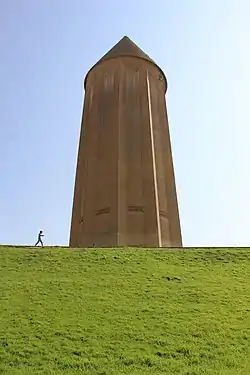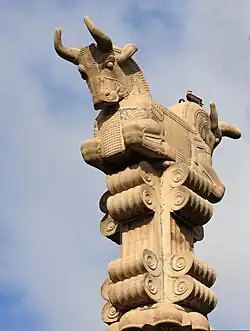Gonbad-e Kavus
Persian: گنبد کاووس | |
|---|---|
City | |
 The historical tower of Gonbad-e Qabus | |
 Gonbad-e Kavus | |
| Coordinates: 37°14′36″N 55°10′09″E / 37.24333°N 55.16917°E[1] | |
| Country | |
| Province | Golestan |
| County | Gonbad-e Kavus |
| District | Central |
| Population (2016)[2] | |
| • Total | 151,910 |
| Time zone | UTC+3:30 (IRST) |
| Website | gonbadcity |
| Gonbad-e Kavus at GEOnet Names Server | |
Gonbad-e Kavus[lower-alpha 1] (Persian: گنبد کاووس, romanized: Gonbade Kâvus) is a city in the Central District of Gonbad-e Kavus County, Golestan province, Iran, serving as both capital of the district and of the county.
At the 2006 National Census, its population was 127,167 in 30,710 households.[3] The following census in 2011 counted 144,546 people in 39,181 households.[4] The census in 2016 showed a population of 151,910 people in 44,731 households.[2]
The modern name, meaning "the tower of Kavus", is a reference to the most imposing ancient monument in the city. The historic name cannot now be restored, because it was assigned to the neighboring historical city of Astarabad in the 1930s by the Iranian government. At one point, it was even known as the city of Dashte Gorgan,[5] meaning "the Plains of Gorgan".
In the historical times, the city's populations were made up of various Iranic peoples such as the ancient and eponymous Hyrcanians, Parthians and eventually the Khurasani Persians. Today, however, the population is a mix of Turkmens, Azerbaijani Turks,[6] Sistanis, Baluch, Semnanis, and Khorasanis.[7]
The city is famous for its historic brick tower of the same name. The city has an ethnically diverse population and the biggest ethnic group is Persians followed by Azeris and Turkmens. The Persians and Azeris tend to mainly follow Shia Islam while the Turkmens are mostly Sunni Muslim.

Historical attractions
The "Divar-i Gorgan" (Persian for "The Great Wall of Gorgan") is a gigantic defensive wall built in the Sasanian period of Iranian history. The visible remains are about 155 km (96 mi) long and 6–10 m (20–33 ft) wide. It is one of the most outstanding and gigantic architectural monuments in northeast Iran and the most impressive in the Golestan Province. This wall, which is the largest defensive wall in the world after the Great Wall of China, starts from the Caspian sea coast, circles north of the city of Gonbad-e Kāvus, continues towards the northeast, and vanishes into the Pishkamar Mountains.
At certain points, the Divar is 6 m (20 ft) wide and in other parts the width is 10 m (33 ft), depending on the nature of the land and the soil type. Watch towers and forts had been built at vaying distances. The longest distance between forts is 50 km (31 mi) and the shortest is 10 km (6.2 mi). The 40 identified forts vary in dimension and shape but the majority are square fortresses. Due to many difficulties in development and agricultural projects, archaeologists have been assigned to mark the boundary of the historical find by laying cement blocks.
The Divar defensive wall has also been known variously as Alexander Dam, Anushirvân Dam, Firuz Dam and Golestan's Defense Wall in various historical texts.
Dr. Kiani, who led the archaeological team in 1971, believes that the wall was built during the Parthian dynasty, simultaneously with the construction of the Great Wall of China, and that it was restored during the Sassanid era (3rd to 7th centuries AD).
Neolithic period
During the Neolithic period, this area had many populated settlements. For example, Yarim Tepe (Iran). The Jeitun culture started before 6000 BC.
Natural attractions
- Aji gol Lake
- Ala gol lake
- Alma Gol Lake
- Chehelchay Forest
- Golestan Forest
- Gonbad Horse Racing Center
Colleges and universities
- Gonbad Kavous University
- Islamic Azad University of Gonbad
- Payamnoor University of Gonbad[8]
Notable people
- Sardar Azmoun
- Farhad Ghaemi
- Parham Maghsoodloo
- Magtymguly Pyragy
- Shahpour Turkian
- Mohsen Yeganeh
See also
- Kay Kāvus
- Decagon
- Iranian Turkmen
- Iranian Art Museum Garden, which includes a replica of the Gonbad-e Kavus tower.
Notes
- ↑ also referred to as Gonbad-e Kāvus, Gonbad-i Kāvoos, Gonbadekavoos, Gonbad-e Kāvūs, Gonbad Qābūs, Gonbad Qavoos, Gunbad-i-Kāwās, Gunbad-i-Kāwūs, Gonbæde Kavus, Günbədkavus, and Gunbad-i-Kāvūs
References
- ↑ OpenStreetMap contributors (13 October 2023). "Gonbad-e Kavus, Gonbad-e Kavus County" (Map). OpenStreetMap. Retrieved 13 October 2023.
- 1 2 "Census of the Islamic Republic of Iran, 1395 (2016)". AMAR (in Persian). The Statistical Center of Iran. p. 27. Archived from the original (Excel) on 29 March 2019. Retrieved 19 December 2022.
- ↑ "Census of the Islamic Republic of Iran, 1385 (2006)". AMAR (in Persian). The Statistical Center of Iran. p. 27. Archived from the original (Excel) on 20 September 2011. Retrieved 25 September 2022.
- ↑ "Census of the Islamic Republic of Iran, 1390 (2011)" (Excel). Iran Data Portal (in Persian). The Statistical Center of Iran. p. 27. Retrieved 19 December 2022.
- ↑ Gonbad-e Kavus can be found at GEOnet Names Server, at this link, by opening the Advanced Search box, entering "-3064799" in the "Unique Feature Id" form, and clicking on "Search Database".
- ↑ Golestannma
- ↑ "شهرداری گنبد کاووس". gonbadcity.ir. Archived from the original on 1 August 2020. Retrieved 31 August 2013.
- ↑ "IIS7". Archived from the original on 15 June 2017. Retrieved 31 December 2019.
External links
![]() Media related to Gonbad-e Kavus at Wikimedia Commons
Media related to Gonbad-e Kavus at Wikimedia Commons
- Iran plans to begin preservation work on the tower. Archived 22 May 2011 at the Wayback Machine

